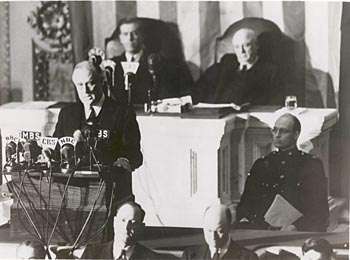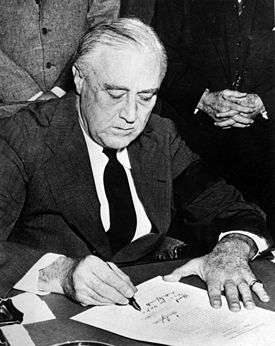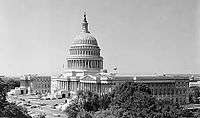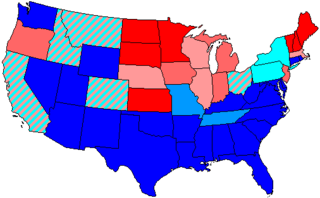77th United States Congress
| 77th United States Congress | |||||||||||||||||||||||||||||
| |||||||||||||||||||||||||||||
The Seventy-seventh United States Congress was a meeting of the legislative branch of the United States federal government, composed of the United States Senate and the United States House of Representatives. It met in Washington, DC from January 3, 1941 to January 3, 1943, during the ninth and tenth years of Franklin Roosevelt's presidency. The apportionment of seats in the House of Representatives was based on the Sixteenth Census of the United States in 1940. Both chambers had a Democratic majority.
This was the first Congress to have more than one Senate President (the Vice President of the United States), John Garner and Henry Wallace, due to the passage of the 20th amendment in 1933.



Major events
- December 7, 1941: Attack on Pearl Harbor
- December 8, 1941: Joint Session of Congress met to hear President Roosevelt deliver his "Day of Infamy" speech
- December 26, 1941: Joint session of the United States Congress met in the Senate chamber for an address by British Prime Minister Winston Churchill.
Major legislation and resolutions
- March 11, 1941: Lend Lease Act, Pub.L. 77–11, Sess. 1, ch. 11, 55 Stat. 31
- August 18, 1941: Flood Control Act of 1941, Pub.L. 77–228, Sess. 1, ch. 377, 55 Stat. 638
- December 8, 1941: Resolution— War between United States and Japan, Pub.L. 77–328, Sess. 1, ch. 561, 55 Stat. 795
- December 11, 1941: Resolution— War between United States and Germany, Pub.L. 77–331, Sess. 1, ch. 564, 55 Stat. 796
- December 11, 1941: Resolution— War between United States and Italy, Pub.L. 77–332, Sess. 1, ch. 565, 55 Stat. 797
- January 30, 1942: Emergency Price Control Act of 1942, Pub.L. 77–421, Sess. 2, ch. 26, 56 Stat. 23
- June 5, 1942: Resolution— War between United States and Bulgaria, Pub.L. 77–563, Sess. 2, ch. 323, 56 Stat. 307
- June 5, 1942: Resolution— War between United States and Hungary, Pub.L. 77–564, Sess. 2, ch. 324, 56 Stat. 307
- June 5, 1942: Resolution— War between United States and Romania, Pub.L. 77–565, Sess. 2, ch. 325, 56 Stat. 307
- June 22, 1942: Resolution— United States Flag Code, including recognition of the Pledge of Allegiance, Pub.L. 77–623, Sess. 2, ch. 435, 56 Stat. 377
- October 2, 1942: Stabilization Act of 1942, Pub.L. 77–729, Sess. 2, ch. 578, 56 Stat. 765
Select committees
- Truman Committee (officially the United States Senate Special Committee to Investigate the National Defense Program)
Leadership
Senate
- President: John Nance Garner (D), until January 20, 1941
- Henry A. Wallace (D), from January 20, 1941
- President pro tempore: Pat Harrison (D), until June 22, 1941
- Carter Glass (D), from July 10, 1941
Majority (Democratic) leadership
Minority (Republican) leadership
House of Representatives
- Speaker: Sam Rayburn (D)
Majority (Democratic) leadership
- Majority leader: John William McCormack
- Democratic Whip: Patrick J. Boland, until May 18, 1942
- Democratic Caucus Chairman: Richard M. Duncan
Minority (Republican) leadership
- Minority leader: Joseph William Martin, Jr.
- Republican Whip: Harry Lane Englebright, until May 13, 1943
- Republican Conference Chairman: Roy O. Woodruff
Party summary
Senate
| Party (shading shows control) |
Total | Vacant | |||||
|---|---|---|---|---|---|---|---|
| Democratic (D) |
Farmer-Labor (FL) | Progressive (P) | Republican (R) | Independent (I) | |||
| End of the previous congress | 68 | 1 | 1 | 25 | 1 | 96 | 0 |
| Begin | 66 | 0 | 1 | 28 | 1 | 96 | 0 |
| End | 64 | 30 | |||||
| Final voting share | 66.7% | 0.0% | 1.0% | 31.3% | 1.0% | ||
| Beginning of the next congress | 58 | 0 | 1 | 36 | 0 | 95 | 1 |
House of Representatives
- 267 Democratic
- 162 Republican
- 3 Progressive
- 1 American Labor
- 1 Farmer-Labor
- 1 Independent Democrat
Total 435
Members
Senate
Senators are elected statewide every two years, with one-third beginning new six-year terms with each Congress. Preceding the names in the list below are Senate class numbers, which indicate the cycle of their election.
House of Representatives
Changes in membership
The count below reflects changes from the beginning of this Congress.
Senate
| State (class) |
Vacator | Reason for change | Successor | Date of successor's formal installation |
|---|---|---|---|---|
| West Virginia (2) |
Matthew M. Neely (D) | Resigned January 12, 1941 after being elected Governor of West Virginia. Successor was appointed to serve until a special election, which he subsequently lost. In addition, successor took oath of office after the Senate resolved a challenge to the appointment. |
Joseph Rosier (D) | January 13, 1941 |
| Arkansas (2) |
John E. Miller (D) | Resigned March 31, 1941 after being appointed judge for the US District Court for the Western District of Arkansas. Successor was appointed to serve until the next election. |
G. Lloyd Spencer (D) | April 1, 1941 |
| Texas (2) |
Morris Sheppard (D) | Died April 9, 1941. Successor was appointed to serve until a special election. |
Andrew Jackson Houston (D) | April 21, 1941 |
| Mississippi (2) |
Pat Harrison (D) | Died June 22, 1941. Successor was appointed to serve until a special election. |
James Eastland (D) | June 30, 1941 |
| Texas (2) |
Andrew Jackson Houston (D) | Died June 26, 1941. Successor was elected to finish term. |
W. Lee O'Daniel (D) | June 28, 1941 |
| South Carolina (2) |
James F. Byrnes (D) | Resigned July 17, 1941 after being appointed Associate Justice of the Supreme Court of the United States. Successor was appointed to serve until a special election. |
Alva M. Lumpkin (D) | July 22, 1941 |
| South Carolina (2) |
Alva M. Lumpkin (D) | Died August 1, 1941. Successor was appointed to serve until a special election. |
Roger C. Peace (D) | August 5, 1941 |
| Mississippi (2) |
James Eastland (D) | Appointee did not seek election to finish term. Successor was elected September 28, 1941 to finish term. |
Wall Doxey (D) | September 29, 1941 |
| South Carolina (2) |
Roger C. Peace (D) | Appointee did not seek election to finish term. Successor was elected November 4, 1941 to finish term. |
Burnet R. Maybank (D) | November 5, 1941 |
| Colorado (3) |
Alva B. Adams (D) | Died December 1, 1941. Successor was appointed to serve until the November 3, 1942 special election, which he won. |
Eugene Millikin (R) | December 20, 1941 |
| West Virginia (2) |
Joseph Rosier (D) | Appointee lost election November 17, 1942 to finish the term. Successor was elected to finish term. |
Hugh Shott (R) | November 18, 1942 |
| Nevada (1) |
Berkeley L. Bunker (D) | Appointee lost election December 7, 1942 to finish the term. Successor was elected to finish term. |
James G. Scrugham (D) | December 7, 1942 |
House of Representatives
| District | Vacator | Reason for change | Successor | Date successor seated |
|---|---|---|---|---|
| Oklahoma 7th | Sam C. Massingale (D) | Died January 17, 1941 | Victor Wickersham (D) | April 1, 1941 |
| New York 17th | Kenneth F. Simpson (R) | Died January 25, 1941 | Joseph C. Baldwin (R) | March 11, 1941 |
| Alabama 7th | Walter W. Bankhead (D) | Resigned February 1, 1941 | Carter Manasco (D) | June 24, 1941 |
| Maryland 6th | William D. Byron (D) | Died February 27, 1941 | Katharine Byron (D) | May 27, 1941 |
| Virginia 2nd | Colgate Darden (D) | Resigned March 1, 1941 to run for Governor of Virginia | Winder R. Harris (D) | April 8, 1941 |
| New York 42nd | Pius L. Schwert (D) | Died March 11, 1941 | John C. Butler (R) | April 22, 1941 |
| North Carolina 5th | Alonzo D. Folger (D) | Died April 30, 1941 | John H. Folger (D) | June 14, 1941 |
| New York 14th | Morris M. Edelstein (D) | Died June 4, 1941 | Arthur G. Klein (D) | July 29, 1941 |
| Wisconsin 1st | Stephen Bolles (R) | Died July 8, 1941 | Lawrence H. Smith (R) | August 29, 1941 |
| Pennsylvania 15th | Albert G. Rutherford (R) | Died August 10, 1941 | Wilson D. Gillette (R) | November 4, 1941 |
| Colorado 4th | Edward T. Taylor (D) | Died September 3, 1941 | Robert F. Rockwell (R) | December 9, 1941 |
| Mississippi 2nd | Wall Doxey (D) | Resigned September 28, 1941 after being elected to the US Senate | Jamie L. Whitten (D) | November 4, 1941 |
| California 17th | Lee E. Geyer (D) | Died October 11, 1941 | Cecil R. King (D) | August 25, 1942 |
| Massachusetts 7th | Lawrence J. Connery (D) | Died October 19, 1941 | Thomas J. Lane (D) | December 30, 1941 |
| Connecticut 5th | J. Joseph Smith (D) | Resigned November 4, 1941 after being appointed judge for the United States District Court for the District of Connecticut | Joseph E. Talbot (R) | January 20, 1942 |
| Pennsylvania 12th | J. Harold Flannery (D) | Resigned January 3, 1942 after becoming judge of common pleas for Luzerne County, PA | Thomas B. Miller (R) | May 19, 1942 |
| Pennsylvania 33rd | Joseph A. McArdle (D) | Resigned January 5, 1942 after being elected to the Pittsburgh City Council | Elmer J. Holland (D) | May 19, 1942 |
| Pennsylvania 11th | Patrick J. Boland (D) | Died May 18, 1942 | Veronica G. Boland (D) | November 3, 1942 |
| Washington 5th | Arthur D. Healey (D) | Resigned August 1, 1942 after being appointed judge for the United States District Court for the Western District of Washington | Vacant until the next Congress | |
| Massachusetts 8th | Charles H. Leavy (D) | Resigned August 3, 1942 after being appointed judge for the United States District Court for the District of Massachusetts | Vacant until the next Congress | |
| Ohio 15th | Robert T. Secrest (D) | Resigned August 3, 1942 after accepting a commission in the US Navy | Vacant until the next Congress | |
| Ohio 13th | Albert D. Baumhart, Jr. (R) | Resigned September 2, 1942 after accepting a commission in the US Navy | Vacant until the next Congress | |
| Iowa 9th | Vincent F. Harrington (D) | Resigned September 5, 1942 after accepting a commission as major in the United States Army | Harry E. Narey (R) | November 3, 1942 |
| California 3rd | Frank H. Buck (D) | Died September 17, 1942 | Vacant until the next Congress | |
| Maryland 2nd | William Purington Cole, Jr. (D) | Resigned October 26, 1942 after being appointed judge for the US Customs Court | Vacant until the next Congress | |
| Pennsylvania 25th | Charles I. Faddis (D) | Resigned December 4, 1942 to enter the US Army | Vacant until the next Congress | |
| Illinois 4th | Harry P. Beam (D) | Resigned December 6, 1942 after being elected judge for the municipal court of Chicago | Vacant until the next Congress | |
| Illinois 6th | A. F. Maciejewski (D) | Resigned December 6, 1942 | Vacant until the next Congress | |
| Missouri 6th | Philip A. Bennett (R) | Died December 7, 1942 | Vacant until the next Congress | |
| Nevada At-large | James G. Scrugham (D) | Resigned December 7, 1942 after being elected to the US Senate | Vacant until the next Congress | |
Committees
Lists of committees and their party leaders.
Senate
- Agriculture and Forestry
- Agricultural Labor Shortages in the West (Special)
- Appropriations
- Audit and Control the Contingent Expenses of the Senate
- Banking and Currency
- Civil Service
- Civil Service Laws (Special)
- Claims
- Commerce
- District of Columbia
- Education and Labor
- Enrolled Bills
- Expenditures in Executive Departments
- Finance
- Foreign Relations
- Fiscal Affairs of the Government (Special)
- Fuel Situation in the Middle West (Special)
- Fuels in the Areas West of the Mississippi (Special)
- Gasoline and Fuel Oil Shortages (Special)
- Immigration
- Immigration and Naturalization
- Indian Affairs
- Interoceanic Canals
- Interstate Commerce
- Investigate the National Defense Program (Special)
- Judiciary
- Library
- Manufactures
- Military Affairs
- Mines and Mining
- Naval Affairs
- Old-Age Pension System (Select)
- Patents
- Pensions
- Post Office and Post Roads
- Printing
- Privileges and Elections
- Public Buildings and Grounds
- Public Lands and Surveys
- Rules
- Senatorial Campaign Expenditures (Special)
- Small Business Enterprises (Special)
- Territories and Insular Affairs
- Whole
- Wildlife Resources (Special)
- Wool Production (Special)
House of Representatives
- Accounts
- Agriculture
- Air Accidents (Select)
- Appropriations
- Banking and Currency
- Census
- Civil Service
- Claims
- Coinage, Weights and Measures
- Disposition of Executive Papers
- District of Columbia
- Education
- Election of the President, Vice President and Representatives in Congress
- Elections
- Enrolled Bills
- Expenditures in the Executive Departments
- Flood Control
- Foreign Affairs
- Immigration and Naturalization
- Indian Affairs
- Insular Affairs
- Interstate and Foreign Commerce
- Invalid Pensions
- Irrigation and Reclamation
- Labor
- Memorials
- Merchant Marine and Fisheries
- Military Affairs
- Mines and Mining
- Naval Affairs
- Patents
- Pensions
- Post Office and Post Roads
- Public Buildings and Grounds
- Public Lands
- Revision of Laws
- Rivers and Harbors
- Roads
- Rules
- Small Business (Select)
- Standards of Official Conduct
- Territories
- War Claims
- Ways and Means
- Whole
Joint committees
- Conditions of Indian Tribes (Special)
- Disposition of (Useless) Executive Papers
- Eradication of the Meditteranean Fruit Fly
- Forestry
- The Library
- Reduction of Nonessential Federal Expenditures
- Taxation
- To Investigate Phosphate Resource of the United States
Employees
- Architect of the Capitol: David Lynn
- Attending Physician of the United States Congress: George Calver
- Comptroller General of the United States: Lindsay C. Warren
- Librarian of Congress: Archibald MacLeish
- Public Printer of the United States: Augustus E. Giegengack
Senate
- Secretary: Edwin A. Halsey
- Sergeant at Arms: Chesley W. Jurney
- Parliamentarian: Charles Watkins
- Chaplain: ZeBarney Thorne Phillips (until October 9, 1942), Frederick Brown Harris (after October 10, 1942)
House
- Clerk: South Trimble
- Sergeant at Arms: Kenneth Romney
- Parliamentarian: Lewis Deschler
- Reading Clerks: Irving Swanson
- Chief Administrative Officer:
- Doorkeeper of the House: Joseph J. Sinnott
- Postmaster: Finis E. Scott
- Chaplain: James Shera Montgomery (Methodist)
See also
- United States elections, 1940 (elections leading to this Congress)
- United States elections, 1942 (elections during this Congress, leading to the next Congress)
References
- House of Representatives Session Calendar for the 77th Congress (PDF).
- Official Congressional Directory for the 77th Congress, 1st Session.
- Official Congressional Directory for the 77th Congress, 1st Session (Revision).
- Official Congressional Directory for the 77th Congress, 2nd Session.
- Official Congressional Directory for the 77th Congress, 2nd Session (Revision).

